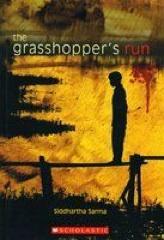

A debut novelist, a book set in the Indian north east, a story of a boy who sets out to avenge his best friend’s murder and another side of Indian history from the early 20th century – that sums up The Grasshopper’s Run.
The story is set in 1944, when the Japanese imperial army invaded British India from the north-eastern hills. Against this backdrop the author develops the story, which begins with a massacre in a Naga village by the Japanese. The dead include young Uti, the grandson and heir of the Ao Naga chief. The perpetrator is identified as Mori and Uti’s grandfather sends his men to avenge the death of his grandson. Joining the group is Gojen Rajkhowa, Uti’s best friend. As he walks side by side with the men of the tribes, he learns about the differences and similarities between them.
A lot of ancient wisdom is narrated through the conversations among the men, “When you hunt, you are placing your hunger against the animal’s desire to live. If your hunger is greater, you will get the animal. But not always.”
The book has won the Vodafone Crossword Award in the children's category for the year 2010.
The book has also won the Sahitya Akademi Award for the year 2011.
Comments
I'd put this book at 15+ as
I'd put this book at 15+ as the events described are really violent and disturbing. Given the theme, it's amazingly sensitive and beautifully evocative. A literary gem, and a must read!
Review submitted for LRSI '14
The book is set in during the 2nd world war in the north-east region of India, mainly Assam. As debut novels come, this is most certainly in the very well written category. It also went on to receive the Vodafone Crossword and BAL Sahitya awards. All the details are well researched and cleanly explained. Siddhartha Sarma’s job as a journalist definitely seemed to help make the book feel professional. The book is supposed to be for 9-12 year olds as the language is easy and not over the top but the content makes it more appropriate for 15-20 year olds.
The novel is based on 13 year old Gojen and how he decided to deal with his best friend’s death. To story starts on a serious and factual note and the same tone is maintained throughout the. The strong point of the story is also somehow the weak point too, the way it’s told.
A good novel is one that will give something to every kind of reader. The writer has kept the nature of the novel as an accurate depiction of the events exactly as they go on. We get to know about Gojen’s character through his actions but other characters were more or less left undeveloped. The novel would have made a great historical account, if it was true. So much effort was given to the facts and details that the emotions were left out.
A small paragraph here and there about how the characters ware feeling would have gone a long way in pleasing readers like me who like to connect with the characters. It is certainly a very well written and well edited book but it could have been made more interesting by experimenting with the emotions.
Aryan Pillai
7 B
Arya Vidya Mandir, Juhu
Mumbai
Review submitted for LRSI '14
1944. A continent ravaged by war in the east and southeast, Asia is being slowly conquered by the Japanese. They plan an attack which will lead them to one of the British strongholds; India. They venture into Nagaland from Burma attempting to locate a British squadron.
An ambitious colonel of the Imperial Japanese Army decides to attack a village of the Ao Naga tribe. No quarter is given. The army massacres all, including the grandson of the eldest Ao Naga chief, Uti.
Gojen Rajkhowa in Calcutta hears the news through another member. Unable to bear with the loss, Gojen returns to the tribe. The chief, Shilukaba orders a personal manhunt for the Japanese colonel, to kill on sight. As Gojen sets out to find the man who took away the best part of his life away from him, through the battle, he must step through the mist surrounding the legend of The Grasshopper and learn the differences and similarities between the Ao Naga tribes. As the hunt continues, ancient wisdom is narrated and Gojen finds that he is trying to hold onto something other than Uti’s memory.
SiddhantSarma brings to light both the wisdom concealed in the tribes as well as many historical events of the Second World War. It is a completely different side of history from a completely different side of India, a side not as renowned as Delhi but a side just as important. This book is a must read for young teenagers, especially those interested in history and mythology. Very tender, and marvelously sequenced, this book provides an insight into the period of extreme violence.
APARAJITO SAHA
8 – A
ARYA VIDYA MANDIR
JUHU
MUMBAI